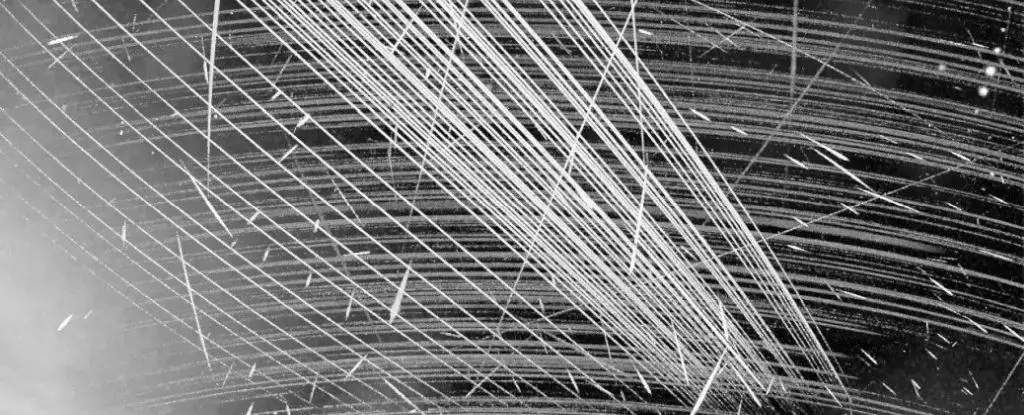As Earth’s orbit becomes densely populated with a multitude of satellites, the consequences are rapidly escalating. New findings reveal that the second generation of SpaceX’s Starlink satellites, specifically the v2mini versions, are leaking an alarming amount of radiation—up to thirty-two times more than their predecessors. This leakage is primarily within radio frequency bands that are essential for radio astronomy, leading to a significant concern among scientists who rely on these frequencies to study celestial phenomena. This issue is compounded by the fact that as of now, over 6,000 Starlink satellites are orbiting the planet, a figure that continues to rise due to SpaceX’s aggressive launch schedule.
The ramifications of this radiation excess become increasingly dire when we consider the dark skies and quiet frequencies that allow astronomers to observe faint signals from the farthest reaches of the universe. Cees Bassa from the Netherlands Institute for Radio Astronomy (ASTRON) sheds light on the stark contrast: the unintended emissions from these satellites are ten million times brighter than the faintest astrophysical sources observed by Earth-based instruments. To put this into perspective, it’s akin to comparing the luminosity of faint stars visible to the naked eye with that of a full Moon. The continuous increase of such emissions cannot be understated; SpaceX launches approximately 40 new second-generation satellites each week, further exacerbating the problem.
The proliferation of satellite swarms causes not only concerns over radio wave pollution but extends to visual pollution as well. Observations taken with optical telescopes often capture streaks of light across the night sky caused by these satellites. While visible light interference is readily apparent, additional research suggests that the impact on radio frequencies is equally troubling. A pivotal study conducted using the LOw Frequency ARray (LOFAR) in Europe demonstrated significant radio wave leakage from these satellites, particularly outside the designated communication bands, which includes essential frequencies used for radio astronomy. This increased brightness complicates the already intricate task of distinguishing faint cosmic signals from background noise generated by human activity.
The satellite operators, including major players like OneWeb and Amazon, must be considered in the context of the broader electromagnetic environment. As these companies deploy thousands of satellites into low-Earth orbit—OneWeb has 634 in circulation and Amazon plans for over 3,000 while China’s Spacesail Constellation aims for 15,000—the cumulative effect of their emissions will likely hinder our ability to explore and understand our universe.
The Urgent Need for Regulatory Frameworks
Currently, there are no regulations addressing the unintended electromagnetic radiation leaking from satellite constellations. Experts are calling for the establishment of comprehensive guidelines that not only govern the operations of these satellite networks but also manage their emissions. Since radiation leakage from a single satellite swarm might initially appear insignificant, the collective emissions from an increasing number of satellites can produce a far brighter and noisier environment, rendering it increasingly difficult for astronomers to perform their work effectively.
Federico Di Vruno, from the SKA Observatory, underscores the importance of this issue, highlighting that humanity is at a critical juncture. The need to preserve our skies as a viable resource for scientific exploration is pressing. Stakeholders in satellite technology must prioritize minimizing unintended radiation within their sustainable space policies, laying an example for future efforts to prevent similar challenges.
Moreover, it is essential to recognize the broader implications of harming radio astronomy. Advances in the field have not only enriched our understanding of the cosmos but have also led to significant technological innovations on Earth, including communications systems like Wi-Fi and GPS, along with advancements in medical imaging. Disturbing radio astronomy could gradually unravel crucial technological developments that we may take for granted.
The collective insights from researchers emphasize a growing need for collaboration between scientists, regulatory bodies, and satellite industry leaders. Calls for support through regulation are resonating within the scientific community, and the hope is that the satellite industry will recognize the importance of mitigating their unintended emissions. With the rapid expansion of satellite technology, the task of protecting Earth’s atmosphere and preserving our ability to observe distant celestial bodies must prevail as a priority.
The road ahead demands that the scientific community gain the cooperation of industry players like Starlink in identifying the sources of and establishing solutions for radiation leakage. Only through proactive measures can we hope to secure a bright yet unpolluted future for the exploration of our universe.

Leave a Reply